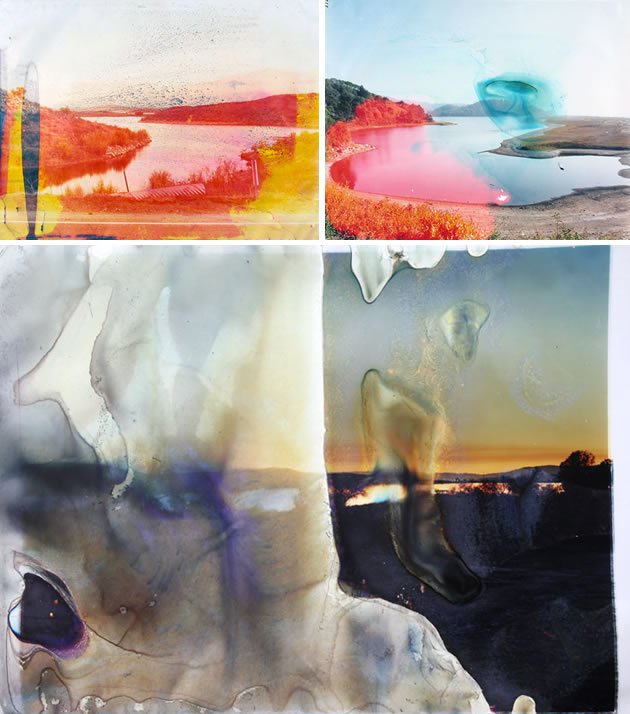CREATIVE PHOTOGRAPHY IDEAS
Students taking high school photography qualifications such as A Level Photography or NCEA Level 3 Photography often search the internet looking for tips, ideas and inspiration. This article contains some creative techniques and mixed media approaches that Fine Art / Photography students may wish to use within their work. It showcases student and artist examples along with brief descriptions of the techniques that have been used. Approaches relate specifically to mixed media photography techniques, technical / trick photography ideas and interesting, fun or unique strategies.
- Stain, smudge and erode photographs using water by, Matthew Brandt

Matthew Brandt has created unexpected and dramatic running of coloured ink by submerging printed photographs in water. After photographing lakes or reservoirs from around the United States, Brandt collects samples of water and brings them back to his studio. He then soaks the c-prints in water from the location that the image represents. Over time, the surface begins to degrade, creating images that are relics of this process. This is a great example of how creative photography techniques can (and should) be driven by the subject or theme that is explored.
- Print photographs onto a flexible surface and stretch or distort them, by Michal Macku

Michal Macku has invented his own technique, which he named ‘Gellage’, whereby photographic emulsion is removed from its paper backing, leaving an image that is semi-transparent and flexible. This allows the image to be stretched and reformed – sometimes combined with other images to make imaginative, distorted and/or surreal scenes – before the artwork is adhered to durable paper.
- Wrap torn plastic or other materials around the edge of your camera to create hazy edges, by Jesse David McGrady

This clever photography trick produces soft, hazy edges around with a photograph, helping to create a seductive, ethereal or other-worldly atmosphere. Jessy David McGrady achieves this effect using a plastic sandwich bag, with a hole torn in the side. He places the ring of plastic around his camera lens, secured in place with a rubber band, leaving rough, torn, slightly crunched edges visible through the viewfinder (but not obscuring the image completely). The intention is that the middle of the image remains well-focused and sharp, while the edges become misty. You can experiment with using marker pens to colour the plastic or increasing the number of layers of plastic.
- Create 3D photography collages,by Midori Harima

Midori Harima makes black and white Xerox copies of photographs on archival paper and uses these to create hollow papier-mâché sculptures, with methyl cellulose paste, archival tape and paperclay (clay that has paper fibres added to it, resulting in a stronger, light-weight modelling product that can make thinner more delicate forms and easily bonds with other mediums when dry). The final works are formed from tiny pieces of the images, exploring ideas about childhood senses and our fragmented absorption of data in an ‘information intensive society’.
- Create 360 degree 3D panoramic photography, by Nemo Nikt

As technology progresses, more cameras and digital image manipulation programs offer the ability to combine multiple shots from different angles into spherical 360 degree photographs (usually with the appearance of little planets or floating worlds). Some cameras use two different lenses to achieve the 3D photography effect, while others use one. Students should be especially careful when using techniques such as this, as the temptation to experiment can overwhelm good judgment, but for certain themes or compositional approaches, 3D panoramic photography may be appropriate, especially if this is used in an artistic, experimental way.
Note: The creative photography ideas listed in this article should not be explored haphazardly within a Photography course, but rather selected purposefully, if appropriate for your topic or theme. These approaches may or may not be relevant for your own photography project and should be chosen only in conjunction with advice from your teacher. The techniques listed here are created using a range of different cameras and devices, such as a digital SLR/DSLR camera, traditional camera, pinhole camera and/or camera phone.
Congratulations @icyy! You received a personal award!
You can view your badges on your Steem Board and compare to others on the Steem Ranking
Vote for @Steemitboard as a witness to get one more award and increased upvotes!